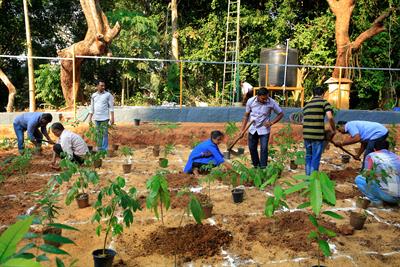PDF chapter test TRY NOW
As measures for conservation, India has an area of 752.3 \ lakh \ hectares classified as reserved forests and 215.1 \ lakh \ hectares, classified as protected forests. The following are some of the important efforts taken for forest conservation:
1. Afforestation:
Afforestation is planting trees or sowing seeds in barren land to create a forest.

Afforestation
Afforestation activities involve planting and protecting trees with multiple trees that aid in the restoration of green cover. Trees should be protected as much as possible, and deforestation must be curtailed.
Van Mahotsav is a great initiative that was started in 1950 to commemorate the importance of cultivating and saving forests and raising awareness about the negative impacts of deforestation. It is observed twice every year (February and July).
The goal of Van Mahotsav is to encourage people in India to plant more trees, as industrialization and urbanization have led to deforestation. Van Mahotsav week attempts to bring more people together to help grow and save forests in India.
2. Reforestation:
Reforestation is the natural or intentional replanting of existing forests that have been destroyed through exploitation.
Reforestation is replanting trees in an area that has lost the forest cover. Reforestation aims to cover the forest again with plants through planting new trees.

Reforestation
3. Separation of commercial forestry:
Commercial forestry should be separated, and industry-specific plants should be grown separately, preferably on wasteland.
Growing plants that are required by industry refers to production plantations.
4. Grazing should be controlled:
Cattle grazing should be strictly regulated and controlled according to pasturage availability.
5. Forest Conservation through Laws:
Through the National Forest Policy (1952 and 1988) and the Forest Conservation Act (1980), stringent laws, regulations and policies were enacted to conserve and protect forests.

Conserve the tree
5. Social forestry:
Social forestry refers to the management, protection of forests and afforestation on barren lands to aid in environmental, social, and rural development. The primary goal of social forestry is to encourage the common man to plant trees to meet the rising demand for timber, fuelwood, fodder etc., thereby relieving the strain on conventional forest areas.
It should be implemented on a large scale, with active public participation and the use of common land to produce firewood, fodder, and timber for the rural community's benefit. This helps relieve pressure on existing forests while ensuring the tribals' long-term survival.
6. Agroforestry:
On the sides of the crop fields, multipurpose trees and shrubs are planted to supply timber, fodder, and fuel. Both social forestry and agroforestry reduce the pressure on forests. Trees are also planted in vacant places and along roadways in urban areas (urban forestry) for reducing pollution.
Reference:
https://upload.wikimedia.org/wikipedia/commons/4/4a/Afforestation_at_Kanakakunnu.jpg
https://commons.wikimedia.org/wiki/File:Reforestation_Praslin_2.jpg
